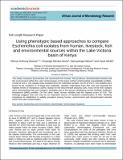| dc.contributor.author | Sifuna Anthony Wawire, Onyango Miruka David, Namuyenga Nelson, Ayub Ofulla | |
| dc.date.accessioned | 2020-08-27T10:31:44Z | |
| dc.date.available | 2020-08-27T10:31:44Z | |
| dc.date.issued | 2013-10-18 | |
| dc.identifier.issn | 1996-0808 | |
| dc.identifier.uri | https://repository.maseno.ac.ke/handle/123456789/2459 | |
| dc.description | The article can also be accessed via URL;https://academicjournals.org/journal/AJMR/article-abstract/5C92E6940457 | en_US |
| dc.description.abstract | The study compares Escherichia coli recovered from human, fish products, domesticated animals and the environment within the Lake Victoria basin on the basis of their antimicrobial susceptibility profiles. A total of 134 E. coli isolates were isolated from the collected samples. 52.2% of the E. coli isolates were found to be resistant to at least one antibiotic. Isolates originating from fish and soil showed the highest levels of resistance (100%). Based on the discriminant analysis (DA), most of the fish isolates were misclassified into soil category, probably due to the groups displaying similar Multiple Antibiotic Resistance (MAR) profiles. On the other hand, human isolates had the highest score of 0.55. The findings suggest that soil may be an important source of bacterial contamination of fish. Similarly resistance to antibiotics is widely prevalent among human, environment and domesticated animals within the Lake Victoria basin. | en_US |
| dc.publisher | Academic Journals | en_US |
| dc.subject | Escherichia coli; Environment; Discriminate; Antimicrobial resistance. | en_US |
| dc.title | Using phenotypic based approaches to compare Escherichia coli isolates from human, livestock, fish and environmental sources within the Lake Victoria basin of Kenya | en_US |
| dc.type | Article | en_US |

